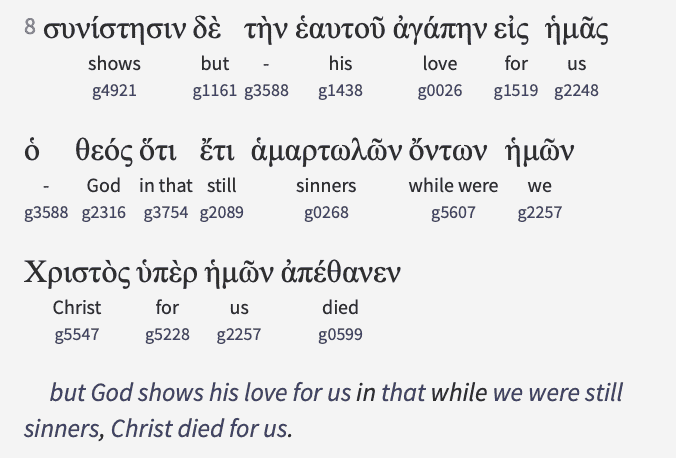God cares about communicating with normal people. He uses different means to do so: nature, the Bible, Jesus, etc. In the written communication of the Bible, the writing was done in the normal language of the human author. For the Old Testament, that means Hebrew or its related language, Aramaic. The New Testament was written in Greek, the language used for universal communication throughout the Roman Empire. Some parts are in “formal” Greek while others are in the commonly-used less-formal koine Greek.
Note: The original writings directly penned by Moses or Paul are not available to us. Neither are the originals of any ancient document. But we have thousands of copies of ancient manuscripts from which to translate, far more than of any other document. Those manuscripts are of varying condition and quality, so translators compare them in order to derive the most accurate rendition of what the very original writings said.
None of those languages are of much use to today’s Americans, or to anyone else except scholars. Even Hebrew and Greek have changed over time, as most living languages do. So, how are we to be able to read and understand the Bible? Answer: Translations.
Early (non-English) Translations
Septuagint – This was a translation of the Old Testament from Hebrew to Greek done about 300 B.C. It would have been the Greek version familiar to Jesus and His disciples, although they would have used the Hebrew versions more often. There are hints of both in the New Testament as they quoted the Scriptures of their time.
Vulgate – This was a translation of the Old Testament to Latin directly from the Hebrew, done by Saint Jerome in about 400 A.D. This replaced older Latin translations that had been mostly translated from the (Greek translation) Septuagint, so they were a step removed from the Hebrew.
Masoretic – Not a translation, exactly, this is the Hebrew text of the Old Testament, carefully collated from many earlier manuscripts during the centuries from 600 to 1000 A.D. The Masorete scholars who worked on the translation were meticulous in transcribing as accurately as possible. For instance, they counted verses, words, and letters to be sure none had been added or deleted during the copying. Their text is now considered the authoritative version of the Hebrew scriptures.
English Translations
Originally, the Bible was available only to clergy or to very upper-class people. Remember, there was no printing press available until Gutenberg’s invention in the mid-1400’s. All copies of Scripture were done by hand, in either Hebrew/Greek or Latin. Ordinary people could not obtain a copy, and would not be able to read those languages if they did.
This meant that the capital-C “Church” determined what the public knew of the Bible. Being human and sinners, some powerful people took advantage of that and taught what they wanted rather than what the Bible really says. Some brave souls defied the Church hierarchy and were determined to make it possible for everyone to read the Bible for themselves.
Wycliffe – This is a translation of the entire Bible, done by (or under the direction of) John Wycliffe in the late 1300’s. The translation was done from from Latin rather than original languages. 1
Tyndale – This is a translation first of the New Testament and part of the Old Testament from the original languages by William Tyndale (for which he was martyred!). Another man, Miles Coverdale, picked up where Tyndale left off, and completed the entire Bible translated from original to English. 2
King James (or Authorized) Version – Authorized by the King James 1 of England, and published in 1611, this remained the most prominent English translation for over 300 years. Note that Shakespeare’s plays were written during this time, between about 1592 and 1616. Now we have the “thee’s” and “thou’s”.
American Standard Version – This revision of the King James version was done in 1901.
Revised Standard Version – This revision of both King James and American Standard, consolidating the two along with new scholarship, was published in 1946.
A series of articles on bible.org has more detail on these early English translations.
More Modern Versions
Any translation, of any text, from one language to another has to make choices. To translate exactly what the original says in Spanish — such as “casa roja” — would be the wrong word order — “house red” — in English. The Spanish phrase “tengo hambre” literally means “I have hunger” but is usually translated for the way that thought is expressed in English: “I am hungry”. Add in the fact that the original languages are ancient and contain many words no longer used in modern Hebrew or Greek, and you can see that translators have quite a task.
They go about that task using various philosophies. Some use literal word-for-word, so they would say “I have hunger”. Some use thought-for-thought, so “I’m hungry” is their choice. Others paraphrase: “I’m starving” or “I need to eat”. I’ll list a few of each style of translation here. You can find more in this article.
Literal translations
- American Standard Version
- New American Standard Bible
- English Standard Version
- New King James Version
Thought-for-thought translations
- Christian Standard Bible
- Common English Bible
- God’s Word Translation
- New International Version
- New Living Translation
Paraphrases
Decisions, Decisions!
To some people, the “thee’s” and “thou’s” of the King James version are what the Bible is “supposed” to sound like. They take comfort in the familiar formal language. To others, that is a distraction. They miss the meaning of the scripture while tangled up in the language.
To some, a modern casual-sounding paraphrase piques their interest. To others, the exact wording matters as a way of digging as deeply as possible into the original exact meaning; for them, the paraphrase comes across as suspicious and losing too much in the translation.
And then there’s the Amplified Version. Rather than choosing the correct English word, it uses several to convey the fullest meaning possible.
My suggestion is to use online software such as blueletterbible.com, olivetree.com or biblestudytools.com to compare translations. For instance, here is the same verse, Romans 5:8, in several translations:
But God commendeth his charity in us; for if when we were yet sinners, after the time Christ was dead for us,
Wycliffe
But God setteth out his love that he hath to vs seinge that whyll we were yet synners Christ dyed for vs.
Tyndale
But God commendeth his love toward us, in that, while we were yet sinners, Christ died for us.
King James
But God demonstrates His own love toward us, in that while we were still sinners, Christ died for us.
New King James
But God shows his love for us in that while we were yet sinners Christ died for us.
Revised Standard Version
But God demonstrates His own love toward us, in that while we were yet sinners, Christ died for us.
New American Standard
But God demonstrates his own love for us in this: While we were still sinners, Christ died for us.
New International Version
But God has shown us how much he loves us – it was while we were still sinners that Christ died for us!
Good News Translation
Christ died for us while we were still sinners. This demonstrates God’s love for us.
God’s Word Translation
But God put his love on the line for us by offering his Son in sacrificial death while we were of no use whatever to him.
The Message Bible
But God clearly shows and proves His own love for us, by the fact that while we were still sinners, Christ died for us.
Amplified Bible
Here is the original Greek, with English translations of each word. The numbers like “g4921” refer to the Strong’s concordance, which cross-references all uses of the same word regardless of how each is translated to English in different contexts.

But whichever translation(s) you read, do read the Bible. God is speaking to you! Choose a translation that is speaking your own language, and listen to Him.
Note: This article barely skims the surface highlights of the information available. For more detail, I suggest the book “How We Got The Bible” by Neil Lightfoot.
Footnotes and Scripture References
- Today an organization named after Wycliffe continues the work of translating the Bible into as many languages as possible.
- Like Wycliffe, there is an organization continuing Tyndale’s work into many languages.


